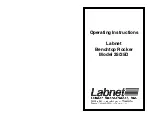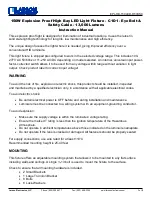
1
VFI SF6 -INSULATED INSTALLATION, OPERATION AND MAINTENANCE INSTRUCTIONS
MN285004EN October 2015
Product information
Introduction
Eaton’s
Service Information MN285004EN
provides
installation instructions, operation information, maintenance
procedures and testing information for Cooper Power™
series VFI SF6 insulated, pad-mounted vacuum switchgear.
The information contained in this manual is
organized into the following major categories;
Safety
Information,Product Information, Installation Procedure,
Operation, Maintenance Information, and Testing
. Refer
to the tableof contents for page numbers.
Read this manual first
Read and understand the contents of this manual and
follow all locally approved procedures and safety practices
before installing or operating this equipment.
Additional information
These instructions do not claim to cover all details or
variations in the equipment, procedures, or processes
described, nor to provide directions for meeting every
possible contingency during installation, operation, or
maintenance. When additional information is desired to
satisfy a problem not covered sufficiently for the user’s
purpose, please contact your Eaton engineer.
Acceptance and initial inspection
VFI switchgear is completely assembled, tested, and
inspected at the factory. The switchgear is filled with
SF6 to a pressure of 7 psig (± 0.5 psi), at an ambient
temperature of approximately 70 to 75°F. It is in good
condition when accepted by the freight carrier for
shipment.
1. Upon receipt, inspect the unit thoroughly for damage
and loss of parts or SF6 incurred during shipment.
If damage or loss is discovered, file a claim with the
carrier immediately.
2. Check and tighten any bolts that may have loosened
during shipment.
3. Check SF6 pressure gauge; the pressure recorded
should be approximately 7 psi at 70°F.
otee:
N
The pressure of SF6 will vary with temperature.
Refer to Table 2 for acceptable pressure/temperature
ranges. When possible, if the unit is cold, move it
to a warm ventilated area, allow gas to warm and
check pressure again. Units with a low reading
should be checked for possible leaks.
4. Record the SF6 pressure, date, ambient temperature
in the SF6 record log (Figure 7). A switchgear
inspection and maintenance log should also be
established and stored with the switchgear. It should
be updated each time the unit is inspected.
Handling and storage
The switchgear should remain on its shipping pallet until
it is installed. When handling the switchgear, always use a
fork truck that has adequate lifting capacity and forks that
extend the entire length of the pallet. Improper handling
can cause damage to the switchgear.
If the switchgear is to be stored for any appreciable time
before installation, provide a clean, dry storage area.
Be careful during handling and storage to minimize the
possibility of mechanical damage. Do not stack other
material on the switchgear.
Product description
VFI vacuum switchgear provides fault interruption
and convenient load switching for 15-, 25- and 35 kV
underground systems. VFI switchgear is designed for
outdoor mounting on a concrete pad. SF6 insulation
provides a compact, low-profile installation. Power is fed
to and from the switchgear from underground through
openings in the pad. Deadfront construction minimizes the
high voltage safety hazards for both the operator and the
general public.
VFI switchgear can be specified with a variety of
control options to meet specific distribution system
protectionrequirements.
Standards
VFI switchgear is designed and tested in accordance with
ANSI standard C37.60 and C37.72.
Quality standards
ISO 9001 Certified Quality Management System
VFI operation
VFI switchgear utilizes vacuum interrupters to provide
fault current interruption and load make/break switching
capabilities. Shotgun stick operable operating handles
are located on the front plate of the unit. VFI operating
mechanisms can be configured for either single or ganged
three-phase operation.
Current sensing transformers, located inside the
switchgear tank, provide line current information to the
control. When line current exceeds the minimum trip
setting, the control initiates a signal which causes the VFI
to interrupt the circuit. Interruption may be single-phase
or three-phase, depending upon the configuration of the
control and VFI interrupter.


































